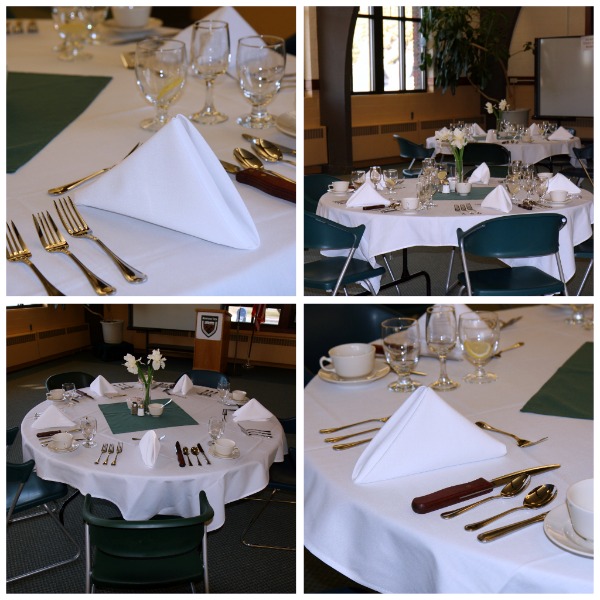Etiquette
 The dictionary definition of “etiquette” is “the form or code of behavior prescribed by custom or authority that delineates expectations for social, official or professional life according to contemporary conventional norms within a society, social class or group.”
The dictionary definition of “etiquette” is “the form or code of behavior prescribed by custom or authority that delineates expectations for social, official or professional life according to contemporary conventional norms within a society, social class or group.”
It is important to remember, the purpose of etiquette is to be attentive to the people around us.
Today, business is often done over a meal. Employers carefully watch what you do so it is essential to understand how to conduct yourself in a professional manner in these situations.
Tips and Guidelines
Below are some tips and guidelines for proper etiquette during a business dinner.
Eating Styles
There are two acceptable ways to use a fork and knife: the American and Continental (European) styles.
- American Style: Cut a few bites (no more than two or three) and lay the knife across the plate with the sharp edge towards you. Switch your fork to your right hand (if right-handed; left hand if left-handed), and keep the fork’s tines up when bringing food to your mouth.
- Continental (European) Style: Cut one bite at a time and keep your fork in the same hand. Keep the tines of the fork down when spearing food and bringing it to your mouth.
Cultural Guidelines
Travel is an important part of modern jobs, and eating in new countries is an important part of travel. It is crucial for you to know the dining etiquette guidelines of the country you are visiting.
Take some time to review eating customs for the country you are visiting so you don’t offend your hosts or embarrass yourself. Consult your local embassy for more information on the country you will visit next.
Alcohol
Employers may take you out to dinner, and there may be alcohol on the menu. Never feel like you have to order a drink, but if you notice they order one, it would be okay for you to get one too. However, don’t order more than one, you can pace yourself by leaving some in the glass. Avoid cocktails and hard liquor. If they aren’t drinking then you shouldn’t either. If you’re unsure, then avoid having a drink. No one will fault you for not drinking, but they will for having too much.
Generally, if the dinner is part of a job interview, do not order alcohol even if they do. If the dinner is meeting clients or an employee get together and people are drinking, it’s fine to order one. If the affair goes on for a long period of time and there is more than one round, it’s okay to participate, but remember the pace yourself rule, don’t drink more than anyone else at the table, and try to make each one last about an hour to an hour and a half pending on the strength and your tolerance. For stronger beers and wines, you may want to make it last longer. Also, don’t forget to eat. Eating will not stop the intoxicating effects, but will slow it down.
A top sales executive gave this advice about “wining and dining” clients: “I always had a beer in my hand but I was the least drunk in the room.”
Dos and Don’ts
DO:
- RSVP for the meal if “RSVP” is on the invitation. This means you need to reply to the invitation to let your host know you will be there. It is rude to not respond.
- Sit down from the left side of the chair and exit from the right.
- Pass the salt and pepper together, even if only one is requested.
- Pass food from left to right.
- Consider the meal as part of the interview process.
- Try to find common, non-controversial interests for conversation, i.e. hobbies, sports, etc.
- Order mid-priced dishes if interviewing since the employer will be paying.
- Thank your host for the wonderful hospitality and send a thank-you note the next day.
DON’T:
- Ignore anyone sitting near you.
- Talk with your mouth full.
- Pick up the check, no matter how long it sits by your plate. Your host will pick it up when ready.
- Offer to share the payment or leave a tip.
Formal Place Settings
Check out this map of a formal place settings and tips for using glasses, plates, bowls, and utensils in a formal dining setting.